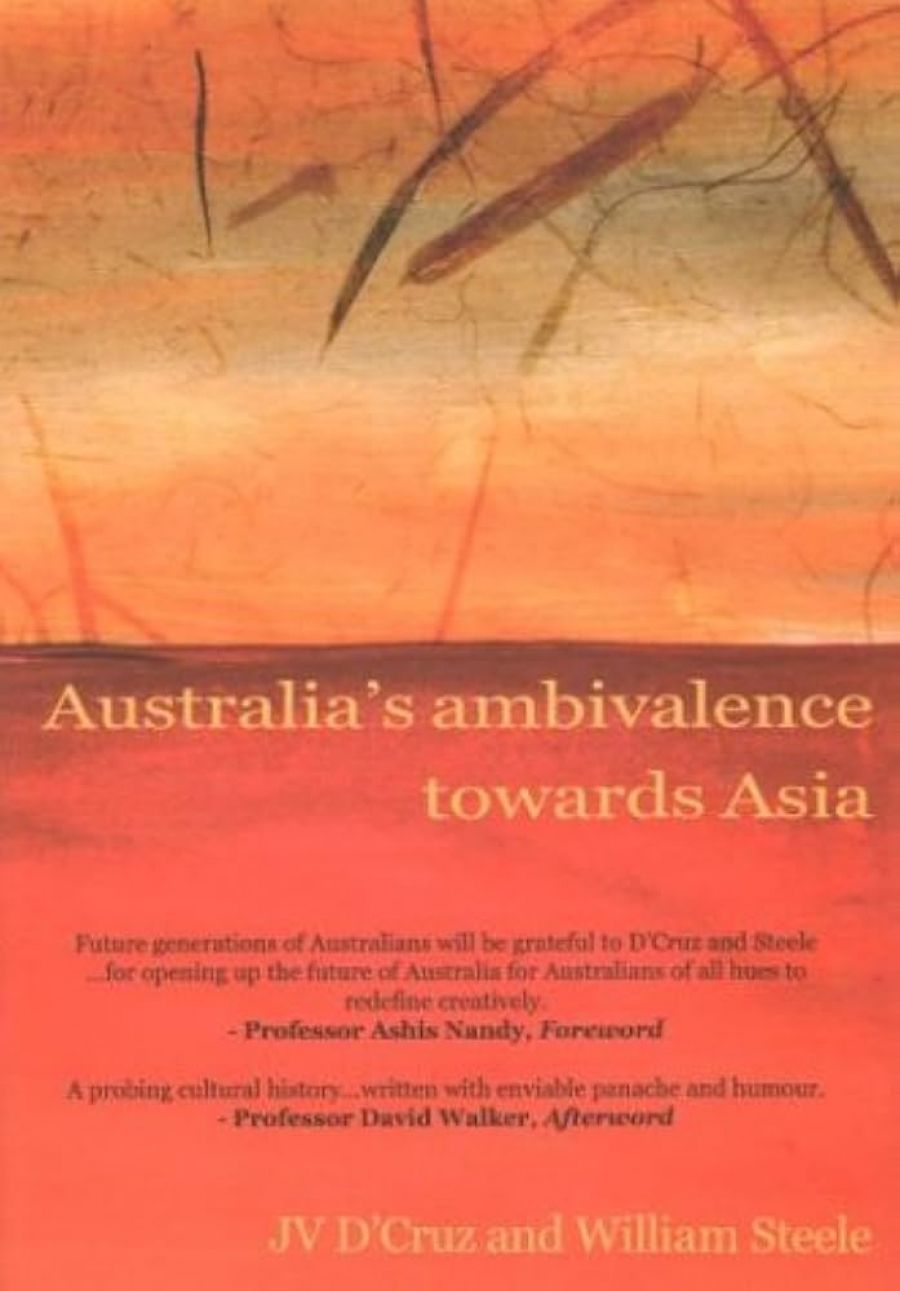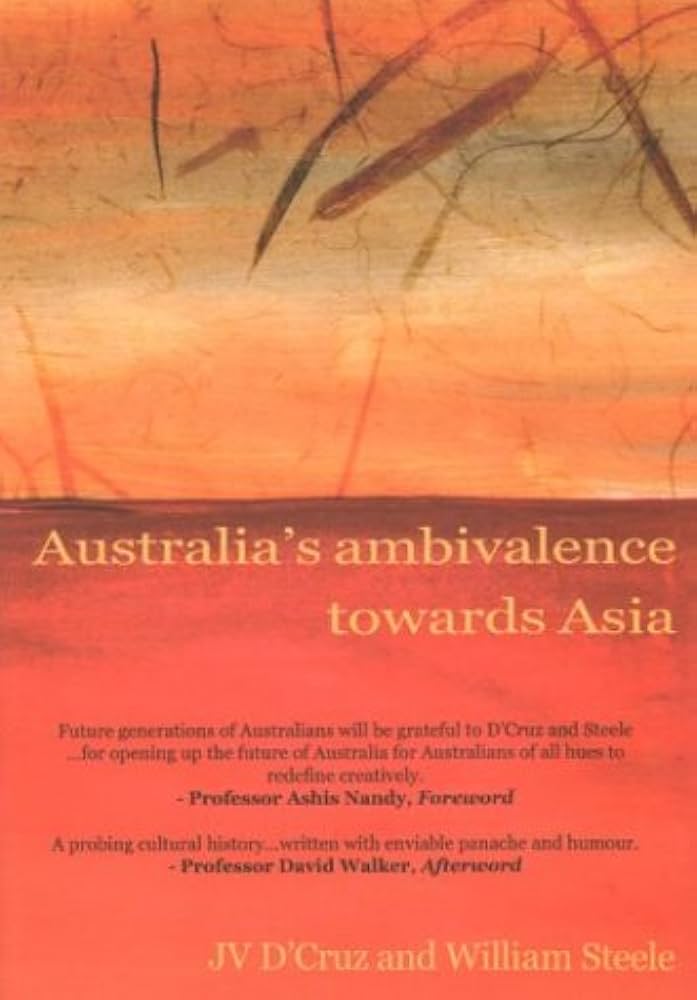
- Free Article: No
- Contents Category: Politics
- Review Article: Yes
- Online Only: No
- Custom Highlight Text:
In the aftermath of 9/11, Americans have been asking why the world hates them. Now it’s Australia’s tum. Why do Asians applaud when Dr Mahathir mocks us? Why docs the Indonesian prime minister snub Australian leaders? Why, despite progress with bilateral trade agreements, do we seem to be permanently locked out of organisations such as ASEAN and ASEM?
- Book 1 Title: Australia's Ambivalence Towards Asia
- Book 1 Subtitle: Politics, neo/post-colonialism, and fact/fiction
- Book 1 Biblio: Monash Asia Institute, $49.95pb, 466pp,
- Book 1 Cover Small (400 x 600):

- Book 1 Cover (800 x 1200):

Along the way, the authors put through the crucible many illusions that Australia has about itself, including its role as a champion of human rights and civil liberties, and its aspirations to be a cultural broker between East and West. They question the benchmarks of liberalism and democracy that Australia sets for Asian countries when it fails so spectacularly to live up to these ideals or to brook international (UN) attempts to enforce them. They question Australia’s identification with Asian countries as a ‘postcolonial’ nation, similarly victimised by the British, when Australia had an active role in colonising its neighbours in the Pacific region. They reiterate that Australians have been conditioned into believing the worst about their Asian neighbours. not only because of discourses of ‘Orientalism’ or fears of the Yellow Peril’, but also because, as Robin Gerster has pointed out previously, ‘War has been the major historical agent in bringing Australians into contact with Asian peoples’, and these wars entrench the Asian as the alien enemy. Above all. however, they provide a detailed analysis of how Australia is perceived by various Asian countries. and this alone makes the book an immensely valuable, if depressing, read.
Having said that, it is a great pity that the book was not written to be more accessible to the general reader. The prose tends towards dense, jargon-ridden phrases. Important passages arc unnecessarily labyrinthine and over-dependent on quotations. Generally, the latter arc used to good effect, but some quotes arc strung together with no explanation as to the original context. There is a lack of generosity towards the intent of some authors, and their words arc deliberately read for hostile meaning. This is particularly true for Turtle Beach, a text already so problematic that the analysis of minor issues almost seems like overkill. This is one of the main problems with this book: there is little sense of proportion in its argument, as if a dragnet has been trawled through Australia’s iniquities and everything caught up – serious and urgent problems, as well as petty grievances – has been dumped into this book.
Yet the most disturbing aspect of this book is its attack on the Western-educated middle classes of Asia who champion democratic reform and human rights in their own countries. The authors dismiss them as ‘Third World compradors who will mimic whatever political garb is in fashion so that they do not appear to Westerners as politically imbecilic’.
Reading this book, one has the feeling that only the poor, the dispossessed, those who cling to traditional and/ or religious mores, rites and rituals arc deemed genuinely and authentically ‘Asian’, and, furthermore, that the majority of Asian governments represent these groups in an unproblematic way, according to their ‘Asian values’. Thus Asian governments, social and religious conservatives, and the poor arc marshalled into alliance against inauthentic Asian ‘elites’, who arc accused of acting out of self-interest. Where is the analysis of the self-interest of governments, big business and the military? This attitude towards the intellectual ‘compradors’ is disconcertingly similar to the British imperial attitude towards Indian ‘babus’: those natives who put on the outward garments of Western culture in order to gain political, social and economic advantage in their own societies. Such a sneering attitude is a way of silencing debate by delegitimising these groups on the basis of their racial and cultural inauthenticity. It fails to recognise people’s agency and the way cultural norms can change, not because people arc brainwashed, but because they can make cognisant choices among alternative values.
The authors argue that the Western agenda of human rights and civil liberties has not found fruitful ground in many Asian countries because there is no natural fit between some of these priorities and the indigenous cultures. They then list alternative approaches to human rights other than liberal humanism. However, they have yet to provide concrete examples of how these theoretical alternatives might work in practice. Until such time, it seems counter-productive to undermine dissenters’ recourse to liberal human rights in order to push for reform.
In denying the intellectual ‘compradors’ a say in their society because they have imbibed the value system of the West, the authors arc guilty of ethnic or cultural essential ism.
Within the Australian scene, this means that they exclude non-Anglo-Australians who do not cling to their traditional cultures; who might feel at ease with, or even prefer, the dominant culture; who might want to integrate into the mainstream or move between different cultural lifestyles, thus creating new identities that arc not based solely on traditional ethnicity. Above all, the attack on the human rights espousing intellectual elites of Asia by Australian academics is deeply troubling in the current Australian political climate, when those Australians who criticise the government’s human rights record arc similarly dismissed with contempt as ‘elites’.
It is easy, living in Australia, to question the priority and value of the compradors’ desire for liberties such as freedom of speech. Yet this book, were it written about any Asian government, would not have seen the light of day in Asia. Ultimately, whether or not the UN Declaration of Human Rights is ‘culturally appropriate’ to Asian countries, most of these governments arc nevertheless signatories to the charter and should therefore be held accountable to maintaining its standards. This applies equally to Australia.
There is no doubt that we have failed to live up to our ideals. The authors warn that one day ‘Australia will be held to account not only for its part in colonial ventures that suppressed nationalist forces in the Asia Pacific region but also for its (at times brutal) suppression of native resistance to European rule in Australia’. Such an occurrence is, however, contingent upon the acceptance of liberal human rights as an international agenda that is admittedly flawed in the implementation, but always worth aspiring to.
Australian readers will need humility, patience and genuine open-mindedness to read this excoriating critique of Australian hypocrisy, but the results are enlightening, thought-provoking and desperately needed. Americans have always reinvigorated their society through the jeremiad. Let’s see whether the Australian jeremiad can do the same for us.


Comments powered by CComment